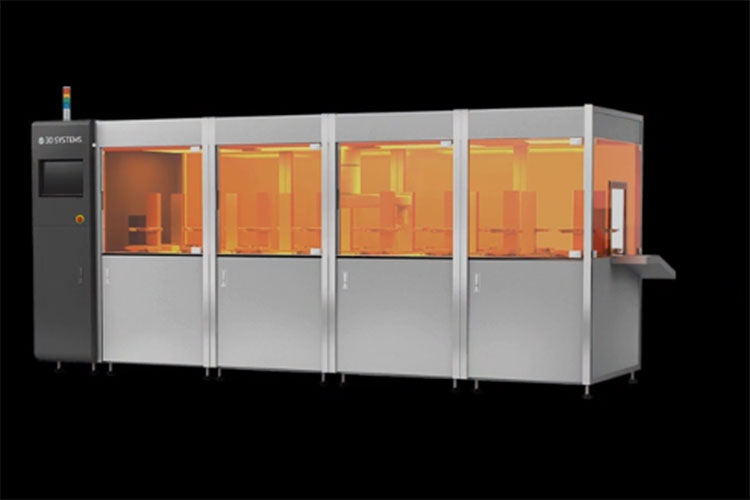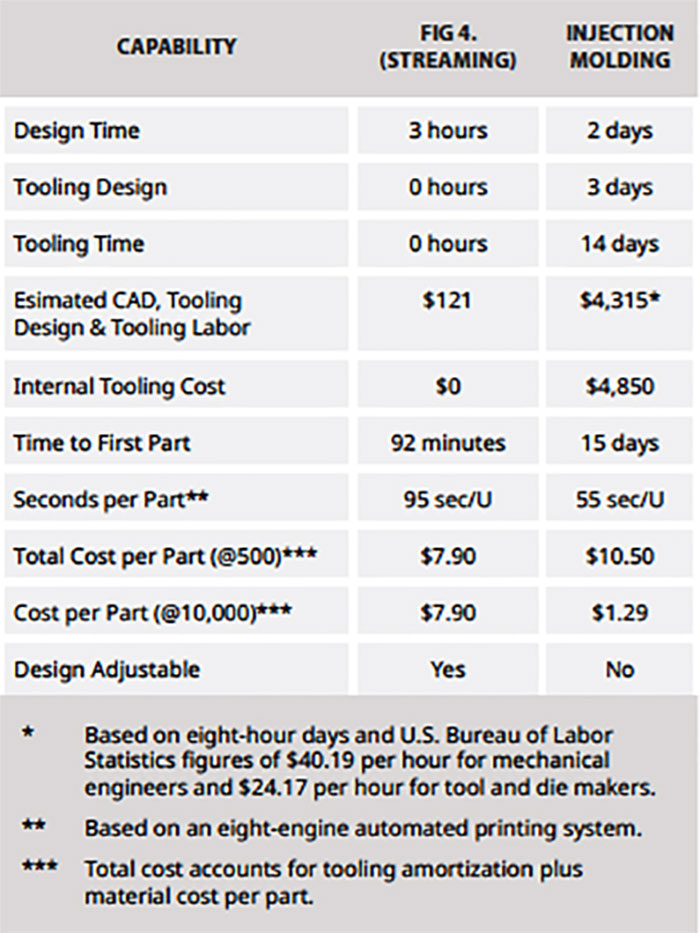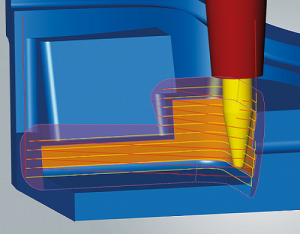Airwolf Launches the EVO 22 3D Printer
Airwolf has just launched its EVO 22 a Core XY 305 mm x 305 mm x 578mm build volume printer has a 315°C maximum extruder temperature and 160°C maximum bed temperature. This lets it print materials such as ABS and PC. The build plate is Borosilicate Glass, it has a 7″ Touchscreen, USB connectivity and no wifi. It has a QuickChange hot end system, linear guides, a ball screw and carbon and HEPA filtration. It works with Cura based Apex, Airwolf’s software and will be available in September for $11,995.
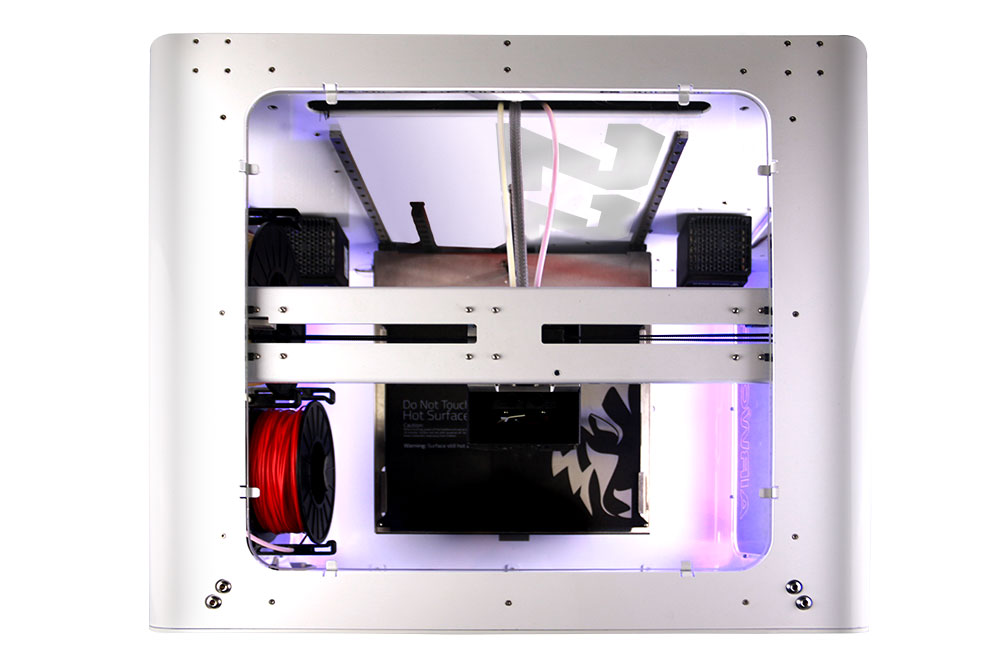
Top View of the EVO 22
The company calls the Evo an Additive Manufacturing Center. Such a lofty name and the accompanying price tag will set expectations very high for the system. In general, our market is bifurcating with the low end being populated by $200 printers and others moving into higher end territory beyond $3000. Airwolf is decidedly moving in the direction of the enterprise and industrial side of things with this machine. Industrial users would not mind the price tag if the machine performs as desired.
Companies expect ease of use, reliability, repeatability and above all little or no downtime. They also want a machine that can make the parts they need. A few years ago desktop companies could not provide this but we are slowly but surely moving into a market where several vendors are exploring the entire proposition around 3D printing. I’ll go into this in more detail at one point but you have to “Control for the 3D printing Decagon” and you have to overcome “Zeno’s boiled frog”. These will both be separate posts but it will take me a while to do them. Essentially, however, a lot more engineering and capability in many more areas will be required to compete in the future. Build quality, quality control and looking at the entire 3D printing experience is very important for the current phase of competition in 3D printing.
Relatively unknown in Europe I’ve always like Airwolf printers such as the Axiom. What makes me optimistic about their company pulling off the EVO 22 is that they have been looking beyond the box at the entire 3D printing experience. They made their own Apex software and have come out with a line of bed adhesion products called WolfBite. The company now has a bed adhesion solution for almost every common 3D print material. Airwolf also lets you lease printers from them and they have a Rent a printer program where you can rent a 3D printer for a week for $175 or $550 for a month. The company also stands by its product through having a 3D printer buyback program where you can get up to $1700 for an old Axiom printer. Its this kind of thinking beyond the box that makes me very optimistic.
The EVO 22 also has two things that are particularly interesting. Genesis and Tri-heat. The company has developed its own microcontroller the Genesis board.
“The GENESIS Board, a custom 32-bit automotive-grade microcontroller developed specifically for delivering higher speeds, more precision, and greater control…(of) temperatures.”
More understanding of microcontrollers and firmware should give the company an advantage going forward. For many OEMs firmware is a major weakness and is retarding their performance. The Genesis also has an automatic shut off of nozzles, motors heated bed and chamber heater with too high temperatures or current which seems like a great idea. Expertise in this area is indeed a good sign. Tri Heat is the other thing that interests me. Rather than using the nozzle or nozzle and bed to heat the chamber, it uses two dedicated chamber heaters. This should speed up startup times and give them a much better thermal environment in the chamber. The chamber by the way which they say they have a patented version for. The company also says that,
“Comprised of two built-in chamber heaters…., rated for 160 degrees Celsius, the Tri-Heat
Build Environment gives users greater control over the machine’s internal ambient temperature, allowing them to create the ideal thermal environment for supporting large part production. Combined with a patent-pending hot end and enclosed chamber design, the TriHeat
technology optimizes and regulates the heat needed to increase part strength while minimizing cracks and warpage.”
That sounds like a great step towards more control and better parts for the user. Thermal control has long been overlooked and could now really become a great area where could see a lot of investment. What do you think of the EVO?
AFPALM: A New 3D Printing Technology Combines 3D Printing with Automated Fiber Placement
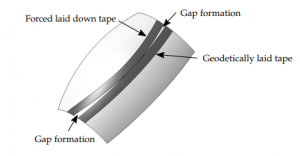 Several methods have been developed for the creation of lightweight composite structures. Two of the most commonly used are automated fiber placement (AFP) and automated tape laying (ATL). These two techniques are well-suited for large and/or geometrically complex structures, and their advantages over manual laydown include productivity and reproducibility. These methods hold a lot of potential for the aerospace industry, where high tolerances are required. However, these methods have their weaknesses: particularly on complex or double-curved surfaces, gaps can appear, reducing the mechanical properties of the composite structure. To counteract this, several layers are laid on top of each other, but this makes the component heavier and more expensive to produce.
Several methods have been developed for the creation of lightweight composite structures. Two of the most commonly used are automated fiber placement (AFP) and automated tape laying (ATL). These two techniques are well-suited for large and/or geometrically complex structures, and their advantages over manual laydown include productivity and reproducibility. These methods hold a lot of potential for the aerospace industry, where high tolerances are required. However, these methods have their weaknesses: particularly on complex or double-curved surfaces, gaps can appear, reducing the mechanical properties of the composite structure. To counteract this, several layers are laid on top of each other, but this makes the component heavier and more expensive to produce.
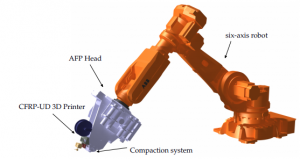 In a new paper entitled “A Novel Approach: Combination of Automated Fiber Placement (AFP) and Additive Layer Manufacturing (ALM),” which you can access here, the authors argue that combining 3D printing with AFP can avoid these problems. So what is AFPALM exactly?
In a new paper entitled “A Novel Approach: Combination of Automated Fiber Placement (AFP) and Additive Layer Manufacturing (ALM),” which you can access here, the authors argue that combining 3D printing with AFP can avoid these problems. So what is AFPALM exactly?
“As the standard, the heads simultaneously lay 8, 16, 24, or 32 layers in the usual widths of 1/800 to 1/200 directly next to each other at the same time,” the researchers explain. “Thermoplastic or thermoset unidirectional (UD)-Prepregs are often used for the automated production of modern high-performance composite materials.”
Prepregs are strips of reinforcing fabric that already have resin, including the proper curing agent, within them.
“The challenge of automated fiber placement is to completely lay down the Prepregs with a defined fiber orientation without gaps or overlaps,” the researchers continue. “Successful fiber placement without gaps or overlaps is dependent on many parameters, such as mold geometry, tape width, and fiber orientation. The Prepregs must be laid down parallel to the flow of force in order to show their optimal properties.”
On a flat surface, prepregs can generally be placed without gaps or overlaps. With complex geometries, however, gaps or overlaps are common, and they can reduce the mechanical properties of the component, and lead to unnecessary material consumption, additional weight, and local thickening.
The researchers present the idea of combining 3D printing with AFP in order to fill in the gaps without adding extra weight. They created three samples: a laminate without gaps, a laminate with gaps, and a laminate in which the gaps were filled with 3D printed unidirectional carbon fiber-reinforced plastic (CFRP-UD).

Microscope images of the laminate structure. (a) Laminate without gaps; (b) Laminate with gaps; (c) Laminate with printed CFRP-UD.
“The tensile strength, interlaminar shear strength, and flexural strength of the laminate with gaps were reduced by about 13% compared to the laminate without gaps,” the researchers state. “Accordingly, the tensile strength of the laminate with printed CFRP-UD was approx. 2%, the interlaminar shear strength was approx. 4%, and the flexural strength was approx. 1% less than that of the laminate without gaps.”
Importantly, the CRFP-UD does not add significant weight to the component, unlike adding multiple layers of prepregs to fill in gaps. The carbon fiber was laid down after an integrated edge detector in the 3D printer head detected the gaps online between the fiber tapes. Another option, the researchers add, would be to have the gaps be detected with a thermal camera integrated in the AFP head.
“By combining the 3D printing and AFP technology, composite parts can be manufactured in a more homogeneous manner,” they conclude. “Subsequently, the components are produced faster, cheaper and even lighter because of the avoidance of the additional layers.”
Authors of the paper include Mohammad Rakhshbahar and Michael Sinapius. AFPALM could be a highly automated process that is very advantageous in terms of costs and parts built for aerospace and other carbon fiber applications. AFPALM itself could be a labor-saving way to create very high strength carbon fiber components for industry. More industries looking at lightweight and lightweight components now have a possible alternative to handlayup and other methods of making carbon fiber parts with AFPALM.
Discuss this and other 3D printing topics at 3DPrintBoard.com or share your thoughts below.
Figure 4 Technology and Dental 3D Printing
The dental industry is increasingly looking to 3D printing as a method for creating implants, guides and tools. The technology allows dental professionals to easily and quickly create implements and implants that are customized to the patient, saving time and money compared to more traditional methods of fabrication. An exciting development in dental 3D printing has come from 3D Systems‘ Figure 4 technology, which promises unparalleled speed and precision in the manufacturing of crowns, aligners and more.
Philip Schultz, Senior Vice President, General Manager, On Demand Manufacturing & Plastics, recently discussed Figure 4 and Digital Molding, which he calls “the next advancement for 3D printing.”
“It provides an immediate solution to tool-based thermoplastic molded production using lab-proven rigorous repeatability,” he says. “New and advanced 3D printers will now behave like other manufacturing equipment, offering longer production runs and comparable repeatability. The tedious process of mold development and tooling is substituted by digital design that can be finished in a matter of hours instead of days or weeks. Although this methodology will not replace injection molding-based mass production, it offers an immediacy of production and a very rapid change of parts being produced. This occurs while tooling is still being designed and machined.”
He explains that recent testing showed that Digital Molding based on Figure 4 technology offers print speeds of up to 100 mm per hour, at six sigma repeatability. Digital Molding can compete with injection molding in aesthetics, function, cost and durability – the key is knowing when to use which technology.
“Digital Molding is a toolless, volume production method for plastic parts,” he says. “To work at volume, the technology must scale to meet a variety of factory situations. To be viable it must equal or exceed traditional injection molding in quality as well have acceptable speed. Benchmark testing found a Figure 4 Digital Molding system of eight modules can turn out 10,000 units of a textured automotive vent in 11 days; traditional injection molding tooling would be produced during those 11 days. Assuming injection molding starts after 11 days, Digital Molding could produce an additional 4,000 units of the vent in the same time that injection molding could produce 10,000.”
Digital Molding’s CAD-to-production speed makes it ideal for Low Rate Initial Production, Schultz continues, or bridge manufacturing. Companies can get to market more quickly by starting with Digital Molding and then switching to or adding injection molding to ramp up production as demand increases.
For the dental industry, Figure 4-based Digital Molding is particularly ideal, as the industry often requires small batches of individually customized pieces. This summer, 3D Systems is introducing NextDent 5100, a new 3D printer that combines Figure 4 technology with the company’s broad portfolio of dental materials. The high-speed system is designed for the production of dental appliances and sacrificial castings, and is compatible with 30 different dental materials offered in a variety of colors to match patients’ teeth and gums.
 The dental industry may be the one that most reveals how 3D printing has come to compete with injection molding – though “compete” may not be the best term. “Complement” may be more accurate. As Schultz says, 3D printing is not going to replace injection molding completely, nor does it need to. In the dental industry, however, it may replace injection molding for certain applications. The manufacturing of dental appliances requires high levels of customization, for which injection molding has never been the most efficient. One of the greatest appeals of 3D printing is its ability to customize and to create multiple unique pieces in a single build.
The dental industry may be the one that most reveals how 3D printing has come to compete with injection molding – though “compete” may not be the best term. “Complement” may be more accurate. As Schultz says, 3D printing is not going to replace injection molding completely, nor does it need to. In the dental industry, however, it may replace injection molding for certain applications. The manufacturing of dental appliances requires high levels of customization, for which injection molding has never been the most efficient. One of the greatest appeals of 3D printing is its ability to customize and to create multiple unique pieces in a single build.
Certain industries benefit more from 3D printing than others, and the dental industry is one of them. It won’t be surprising to see 3D printing continue to infiltrate the dental market, especially as technology like Figure 4 advances and becomes more available.
Discuss this and other 3D printing topics at 3DPrintBoard.com or share your thoughts below.
UBOT P440 3D printer technical specifications, pricing and insights from COO
Polish 3D Printing Company UBOT3D Launches High Temperature Printer

There are a surprising number of 3D printing companies coming out of Poland. Vshaper and 3DGence are two emerging firms that both make high temperature printers. These are now joined by a colleague UBOT3D. UBOT3D is like many 3D printing companies moving up in the world making more expensive 3D printers that are capable of handling high performance materials such as PEEK and PEI. Acording to CEO Michal Melon , they’ve been around since “2015 and made and sold hundreds of 3D printers to polish and euroepan customers. Until this year we were focused strictly on the desktop market, but simultaneously designed an industrial grade machine using the same FFF technology.”

Ubot3D Build chamber.
Enclosed chambers, ventilation and higher quality is what many industrial customers want. Increasingly firms are heeding the call and making systems suited for the shop floor or for manufacturing rather than just sitting on someone’s desktop. Is the UBOT3D’s new system a capable one that can actually manufacture at scale? This is something we don’t know yet but if we look at the specs then the company at least is on a route to a promising device.
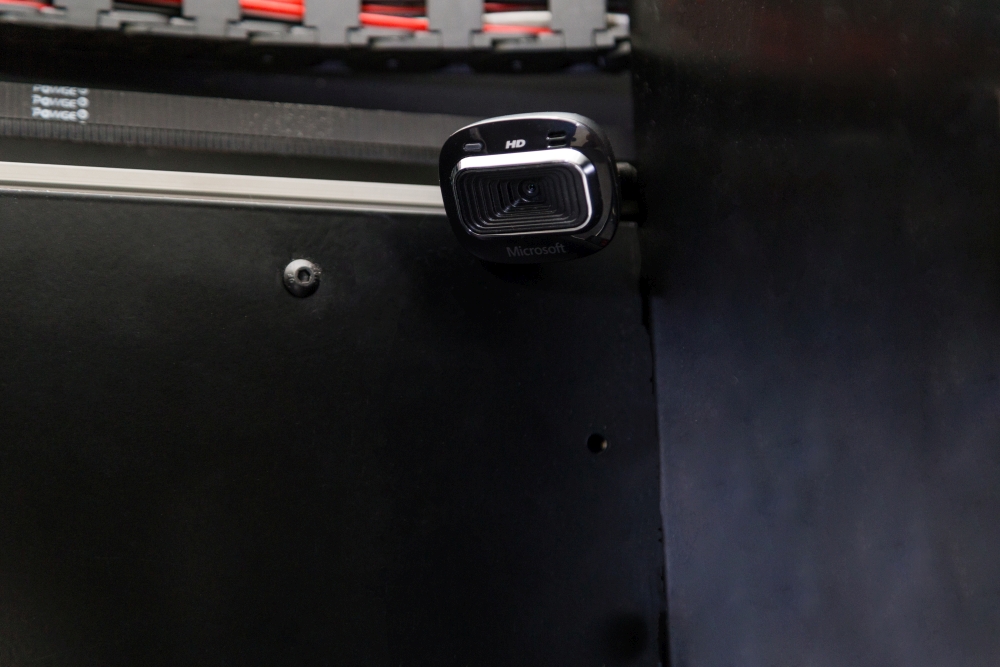
I sure hope this isn’t inside of it.
The P440 printer has a build volume of 440 x 330 x 300 mm and a 1500 W chamber heating system. It seems to have two ball screw and two linear guides inside of the chamber the guides seem enclosed but I wonder if the guides and ball screw will hold up like that. Specifically I’m wondering what will happen to the ball screw lubricant if the chamber becomes 400 C. The idea of having a seperate complete chamber heater is a solid one since lack of thermal control over the heated chamber and the wicking of heat is an issue with many high temperature 3D printers. If this system does maintain a constant temperature and can heat it up properly then this will be an advantage.

Ubot3D Build chamber.
The team also installed a four stage chamber filter of HEPA, carbon, PP and cold catalysis. Which sounds very safe indeed although I must confess to have no idea what cold catalysis is. The print bed is fastened with magnets, which is a nice feature, and it is powered by an 800 W heating unit. Which makes me think that its a good thing that there we do not yet have these EU energy efficiency ratings for printers. This should however give your bed a lot of heat and power which is great. Print bed maximum temperature is 150C, nozzle maximum is 400C. The 400 degrees is a tad limiting for some PEEK-like materials but if they have adequate chamber control they should be able to print most high performance materials. And they have automated leveling where, “the software creates the entire table image and then generates its image using the finite element method. This ensures that the print bed of the 3D printer will be calibrated correctly.” They say that their Hellfire hot end has been optimized for high temperature materials and the team has developed their own extruder as well as an own hot end. Its nice to see someone not using a E3D hot end, I would just hate it if Sanjay became too wealthy. The P440 also has automatic updating, a nice emergency off switch, expert mode and on board camera as well as an app to control the printer and can SMS you if there is an issue with the filament or if you’re running out and it costs 13,000 Euros which is $15,000. This makes it double the price of the Intamsys Funmat HT and more expensive than a Vshaper Pro and around 10k less than a 3Dgence Industry F340 and and around the price of an Intamsys Funmat Pro HT. If the performance is there then its a good price point to be at. But, it will have to be significantly better than a Funmat and a bit better than a Vshaper to even be considered by many. UBOT3D is at a sweet spot for HT printing but at the same time this is a part of the market that cares about performance and reliability above all else.

The Ubot does have two very unique features. Appearantly the printer, “has been equipped with the ability to order filaments directly through the device” and it can work for 30 minutes on auxiliary power if the lights go off. Yes people the days of chucking some rods and stepper motors into a box are gone. We have arrived in featureville, expect more features, demand more features. At first glance the UBOT3D has spent a lot of time thinking about features users care about. The things that their machines has on board are things that people do care about. It is exactly these features that allow for office friendly production that will get the next generation of corporate 3D printer customers.
Allevi partners with Made In Space for first zero gravity tissue 3D printer
Markforged cleared of IP infringement, Desktop Metal awaits countersuit
3D Printing News Briefs: July 27, 2018
We’ve got plenty of awards and other business news for you today in 3D Printing News Briefs. Sinterit and ViscoTec each received awards for their technology, while Arkema announced that it is opening a 3D Printing Center of Excellence at its Pennsylvania facility. Vectary and Sketchfab are integrating, and Xometry is now offering SLA 3D printing. Finally, OPEN MIND Technologies has introduced its latest hyperMILL CAM software.
Sinterit Lisa Receives Award from All3DP
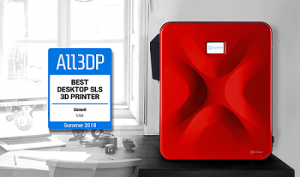 Sinterit, one of the fastest growing manufacturers of SLS 3D printers, just received the “Best Desktop SLS 3D Printer Summer 2018” award for its Lisa 3D printer by All3DP. The award shows that the company is moving in the right direction, and confirms that the Lisa is the perfect choice for 3D printing professionals looking to upgrade to SLS technology without breaking the bank. Even better for Sinterit: the award was announced in the final week of a pre-order period for its upgraded Lisa model, which will feature better hardware, bigger 3D prints, and easier maintenance.
Sinterit, one of the fastest growing manufacturers of SLS 3D printers, just received the “Best Desktop SLS 3D Printer Summer 2018” award for its Lisa 3D printer by All3DP. The award shows that the company is moving in the right direction, and confirms that the Lisa is the perfect choice for 3D printing professionals looking to upgrade to SLS technology without breaking the bank. Even better for Sinterit: the award was announced in the final week of a pre-order period for its upgraded Lisa model, which will feature better hardware, bigger 3D prints, and easier maintenance.
“All3DP is happy to present the Sinterit Lisa with the award for Best Desktop SLS 3D Printer on the market. We recognize the Sinterit team for their tremendous work in making SLS 3D printing technology more affordable and accessible,” said Tyler Koslow, Editor at All3DP. “Additionally, their recent update to the Sinterit Lisa and development of the new Sinterit Lisa 2 PRO suggests that they will remain a market leader for a long time.”
ViscoTec Awarded Special Title Two Years Running
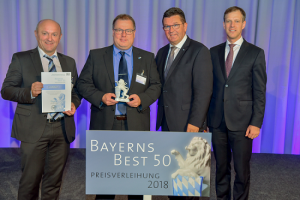
Georg Senftl (holding certificate) and Martin Stadler (holding lion) accepted the award on behalf of all ViscoTec employees.
For the second year in a row, German company ViscoTec, which specializes in pump and dose technology and has 3D printing viscous liquid products for silicone and other materials was awarded the “Bayern’s Best 50” title. For 17 years, the Bavarian Ministry of Economic Affairs has honored the 50 most dynamic, medium-sized companies in Bavaria, and the jury considers criteria such as number of employees, turnover, and social and economic contributions. ViscoTec, and the other 49 winning companies were personally awarded the title, a certificate, and a Bavarian porcelain lion by Bavaria’s Minister of Economic Affairs, Energy and Technology Franz Josef Pschierer at a recent event in Schleißheim Castle.
“Our employees all over the world actively help us to be such a successful company every day and that we will continue to develop very well in the future. Special thanks also go to our partners and customers. Their partnership with ViscoTec is constantly driving us forward. This motivates us not to stand still, to open up new possibilities and to find solutions for the daily challenges,” said Georg Senftl, Commercial Director of ViscoTec Pumpen- u. Dosiertechnik GmbH. “Last but not least, the innovative climate in the Inn-Salzach region contributes to the continuous development of companies like ViscoTec.”
Arkema to Open 3D Printing Center of Excellence
This Monday, July 30th, speciality chemical and advanced materials developer Arkema will be holding the grand opening for its new 3D Printing Center of Excellence. The center will be located at the Exton, Pennsylvania facility of its Sartomer subsidiary, which designs engineered resins for UV-curable additive manufacturing under its N3xtDimension brand. The 3D Printing Center of Excellence will work to advance 3D printing resins technology and be home to most UV-based 3D printing technologies, such as Digital Light Processing (DLP), stereolithography (SLA), and HP’s Multi Jet Fusion (MJF). It will offer a collaborative space for developing custom resins, and complete the company’s worldwide R&D network, which is dedicated to developing advanced 3D printing materials.
“Sartomer is a historic partner for 3D printing pioneers. We’re launching the 3D Printing Center of Excellence to deepen our support of the visionaries working to develop innovative 3D printed materials,” said Sumeet Jain, Global Director, 3D Printing at Sartomer.
Vectary Integrates Sketchfab
 Online 3D design tool Vectary is giving its users access to thousands of new 3D models, as it has now integrated Sketchfab, the world’s largest platform for interactive 3D content. Vectary users can connect to the Sketchfab library and import hundreds of thousands of 3D models with one click, as well as export, publish, and even sell their own 3D work on Sketchfab. Vectary CEO Michal Koor, who co-founded the tool in 2014 with Pavol Sovis said, “Easily importing Sketchfab 3D models in the Vectary 3D tool can be a great way to create design concepts and bring more inspiration to their work. Exporting their Vectary models to Sketchfab gets them exposure to a larger audience, which can mean an increased customer base and new income possibilities by selling their work on one of the best 3D marketplaces available.”
Online 3D design tool Vectary is giving its users access to thousands of new 3D models, as it has now integrated Sketchfab, the world’s largest platform for interactive 3D content. Vectary users can connect to the Sketchfab library and import hundreds of thousands of 3D models with one click, as well as export, publish, and even sell their own 3D work on Sketchfab. Vectary CEO Michal Koor, who co-founded the tool in 2014 with Pavol Sovis said, “Easily importing Sketchfab 3D models in the Vectary 3D tool can be a great way to create design concepts and bring more inspiration to their work. Exporting their Vectary models to Sketchfab gets them exposure to a larger audience, which can mean an increased customer base and new income possibilities by selling their work on one of the best 3D marketplaces available.”
Xometry Adds SLA 3D Printing to List of Services
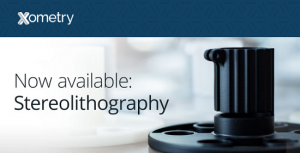 3D printing service provider Xometry has added stereolithography (SLA) 3D printing to the list of 3D printing processes it provides. Versatile SLA technology offers higher resolution 3D printing, which will allow Xometry’s customers to achieve prints with good surface finish and fine detail – perfect for production parts and prototypes. The technology also enables you to print large products and parts and can create complex parts, to meet tolerances of +/- 0.004” or +/- 0.001” per inch, in a single operation.
3D printing service provider Xometry has added stereolithography (SLA) 3D printing to the list of 3D printing processes it provides. Versatile SLA technology offers higher resolution 3D printing, which will allow Xometry’s customers to achieve prints with good surface finish and fine detail – perfect for production parts and prototypes. The technology also enables you to print large products and parts and can create complex parts, to meet tolerances of +/- 0.004” or +/- 0.001” per inch, in a single operation.
Xometry also offers plenty of SLA-friendly materials, such as the Accura and Somos brands. Try it out today – upload your 3D CAD file to Xometry now to get an instant SLA quote.
New Version of hyperMILL CAM Software Released
Germany CAD/CAM software solutions develop OPEN MIND Technologies AG has released the latest version of its advanced CAM software, hyperMILL 2018.2, which provides more machining efficiency and several new enhancements and features. 3D Z-level Shape Finishing, available in the hyperCAD -S module, now comes with automatic face extension to automatically extend selected milling surfaces during CAM programming, and can now also support conical barrel cutters.
This version also provides a “V sketch” command, which allows users to make easy changes to turning contours and milling boundaries by assigning geometric constraints to 2D contours. Other enhancements to the -S module include being able to measure and record distances between two shapes, like meshes, solids, and face models.
Alan Levine, Managing Director of OPEN MIND Technologies USA, Inc., said, “Keeping the hyperMILL suite at the forefront of CAM technology, we are pleased to offer our customers improved CAM strategies and enhanced CAD tools for even greater machining productivity through our new release of hyperMILL 2018.2.”
Discuss these stories and other 3D printing topics at 3DPrintBoard.com or share your thoughts in the Facebook comments below.
We Have to Take a Stand on 3D Printed Guns
We as a 3D Printing community to take a stand on 3D printed guns.
I don’t know where you stand politically on the gun debate, nor do I care. We must as a 3D printing industry collectively respond to the issue of getting dragged into the gun debate. We are being collectively smeared and our technology may be curtailed in its growth because of it.
Through politicians, lobbyists and rabble-rousers our industry is being politicized. Slowly but surely they will try to tear us asunder, separating us. What we need to keep in mind is that they don’t care about us or our industry. They have ulterior motives meant to lead the world towards their way of thinking. They don’t care what they say or do as long as their team wins. We should be mindful of much more powerful forces than we.
You can already make guns in the US, you just need a license to distribute guns. The essential part of the “homebrew” gun was already perfectly possible. If they really wanted to 3D print guns they could have already done this. Instead, they wanted to 3D print attention and everyone fell for it. They went looking for a law suit to prolong the window of attention on them.
The gun people sued the government and the government settled. Now one political arm is settling while the other clamours for a legal solution. It seems like the politicians have found a way for both of them to win while they solve nothing for any of us.
We’ve become a political football not through our own doing but through circumstance. On the upside, we sold over a million 3D printers before one ended up in the hands of a bad guy. Media savvy, this person interjected themselves into America’s gun debate. He became popular and sold many magazines while making comparatively few. The constant attention meant that more people talked about him.
The 3D printed gun was created by the media. It is they who I will blame once the first person dies because of this.
The media made the 3D printed gun, Cody just had the idea for it.

What if I told you that I could make any object out of glass, what would you say? What if I got to go to all the major TV stations to tell my glass blowing story? Nothing would happen. But, what if people kept talking about how I could blow “ghost guns” out of glass? Then eventually if the media gave me enough attention, I’d get enough money and supporters to make glass blown ghost guns happen. What is occurring is that media attention has created a self-fulfilling prophecy. Meanwhile, the current sharing and making of guns by the group advocating it is done using a CNC mill. The 3D printing element is just for marketing.
Making guns at home has been possible with CNC and other tools for many years. Indeed in any modern machine shop, one can find a myriad of tools much better suited to making guns than 3D printers are. Metal guns made with lathes and the like will outperform 3D printed ones by a significant margin.
The designs that are being made and distributed now are not optimized for 3D printing. Clearly, this is not being done by people who are familiar with the technology. The material choices and way they deal with certain engineering choices shows poor judgement and little 3D printing and engineering skill. It is at least reassuring that no one from our community seems to be involved. Instead, it is a group that wishes to become popular through exploiting high interest in the gun debate. This is actually very similar to how (INSERT SOMETHING ANYTHING HERE) is being politicized.
What is happening here is that certain legislators and the companies that they represent would like to implement DRM for 3D printing and restrict the technology. They periodically dig up the same lobbyist talking points: product safety, intellectual property, product liability etc. This lobbying and the same talking points are being spread in the US and EU.
It seems that there are people who wish to restrict the technology through specific legislation aimed at curtailing 3D printing.
This is inane. There is no need for separate safety, IP or liability law for 3D printing. It would be like having different free speech laws for things written by pencil from those written by pen. 3D printing is a technology for making things and should not be curtailed by laws throttling innovation.
The gun boogyman was weaned, popularized and created by the media and is now being used by lobbyists to introduce new legislation to hold back 3D printing.
3D printing democratizes innovation, production and competition. It would seem that there are people who are so afraid of this that they wish to legislate problems for 3D printing as a technology.
People have been trying since 2013 to present DRM as the solution for 3D printed guns.
Using DRM for 3D printers would be akin to installing an app on everyone’s Google Drive or Microsoft Word to monitor for the typing of illegal phrases. Its easy to see where this in a design and engineering context could lead to problems.
DRM for 3D printing will not work because one could always circumvent it by making your own 3D printer without DRM.
In fact, DRM for 3D printers may very well be illegal in the EU, with certain files, especially medical ones and companies deploying a DRM tool that would take patient or personal data out of the EU or handle it incorrectly could be liable for significant fines under EU privacy laws.
On the one hand, you’re saying that we can print guns, but you’re simultaneously saying that adding some chip to every printer is going to somehow stop us?
What if I wanted to make a gun-like shape on a printer? Such as a tube, am I going to be stopped in creating this?
What if using the design freedom of 3D printing I was to make a supremely un-gunlike shape that worked as a gun? Would that be possible? Well…more than possible, along with speed, that is kind of the point of our technology.
There is nothing intrinsically new or particularly dangerous about 3D printed guns. The biggest threat at the moment is to the operator.
There are approximately 270 million guns in the US, every single one of them more dangerous and a better weapon than the 3D printed guns of now.
Having said that, if we talk about it long enough and people keep giving these guys money then they’ll get there eventually. With 3D printing, given enough eyeballs all things are shallow.
Image Creative Commons Attribution Endlesspics.


